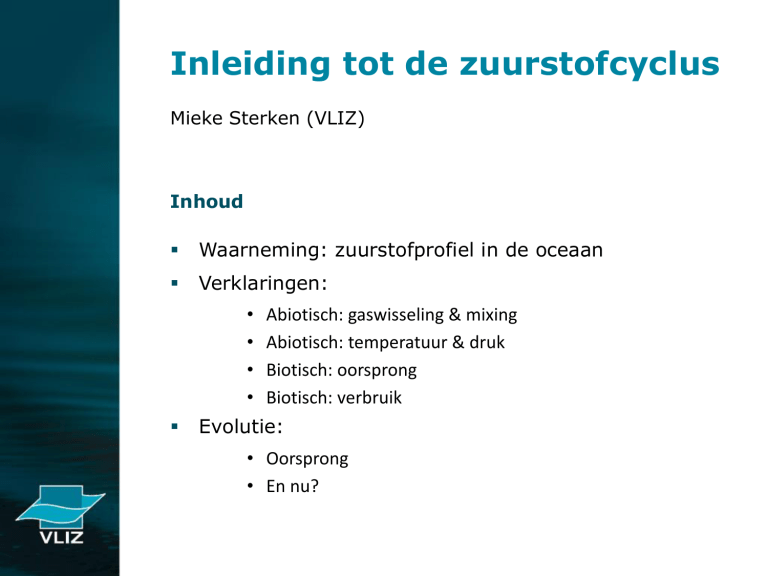
Inleiding tot de zuurstofcyclus
Mieke Sterken (VLIZ)
Inhoud
Waarneming: zuurstofprofiel in de oceaan
Verklaringen:
•
•
•
•
Abiotisch: gaswisseling & mixing
Abiotisch: temperatuur & druk
Biotisch: oorsprong
Biotisch: verbruik
Evolutie:
• Oorsprong
• En nu?
Waarneming: zuurstofprofiel
OMZ
OMZ
© Bruce Railsback (UGA):
www.gly.uga.edu/railsback/FundamentalsIndex.html
Verklaringen:
Abiotisch
•
Gaswisseling & mixing
- Uitwisseling van gassen aan het oceaan-oppervlak
- Goede mixing, tot aan de pycnocline (c. 100 m diep): drukverschil
(Bron: http://worldoceanreview.com/en/wor-1/ocean-chemistry/oxygen )
Verklaringen:
Abiotisch
•
Gaswisseling & mixing
Meer O2 in Atlantische diepzee dan in Pacifische diepzee
(Figuur: © NASA)
Verklaringen:
Abiotisch
•
•
Gaswisseling & mixing
Temperatuur & druk
Diepzee:
- kouder => meer opgeloste O2
- hogere hydrostatische druk
=> meer opgeloste O2
Verklaringen:
Abiotisch
•
•
Gaswisseling & mixing
Temperatuur
Biotisch
•
Oorsprong
Zonlicht
Fotische zone
Figuur: SeaWiFS Project, NASA/Goddard Space Flight Center & ORBIMAGE
Fotische zone
Fytoplankton
Plankton: ‘zweeft’
Fyto: ‘plantjes’: fotosynthese
O2
CO2
(Cyano)bacteriën
(Prokaryoten)
koolhydraten
bv. suikers
Eukaryoten
Fotische zone
Fytoplankton
Plankton: ‘zweeft’
Fyto: ‘plantjes’: fotosynthese
O2
CO2
(Cyano)bacteriën
(Prokaryoten)
Figuur: © G.Gorick – CLAMER / VLIZ
(http://www.vliz.be/projects/clamer/outreach/booklet.html)
koolhydraten
bv. suikers
Eukaryoten
Fotische zone
Fytoplankton
1 L: 100,000-100 M algen
Plankton: ‘zweeft’
Fyto: ‘plantjes’: fotosynthese
O2
CO2
(Cyano)bacteriën
(Prokaryoten)
c. 50% van de O2-productie
Figuur: © WWF
koolhydraten
bv. suikers
Eukaryoten
Fotische zone
Fytoplankton
Plankton: ‘zweeft’
Fyto: ‘plantjes’: fotosynthese
O2
CO2
(Cyano)bacteriën
(Prokaryoten)
Estimates of autotrophic biomass (1997-2000)
Ocean: Chlorophyll-a concentration (mg/m3)
Figuur: © SeaWiFS
koolhydraten
bv. suikers
Eukaryoten
Volvox
Micrasterias
(sierwier)
Diatomeeën
(kiezelwieren)
Coccolithen
Diatomeeën
(kiezelwieren)
Coccolithen
(Emiliana huxlei)
Phaeocystis
schuimalg
Noctiluca scintillans (zeevonk (dinoflagellaat))
Voedingssuplementen
Spirulina
Chlorella
Haematococcus
Haematococcus
bevat het rode
pigment
‘Astaxanthine’
dat een sterk
anti-oxidant is.
Rijk aan mineralen, koolhydraten en anti-oxidanten
Voedingssuplementen
Spirulina
Chlorella
Rijk aan mineralen, koolhydraten en anti-oxidanten
Haematococcus
Isochrysis
Voedsel voor zooplankton (kleine waterdiertjes)
op hun beurt voedsel
voor vis & jonge
Nannochloropsis
dieren
Biodiesel
Verklaringen:
Abiotisch
•
•
Gaswisseling & mixing
Temperatuur
Biotisch
•
Oorsprong
Verklaringen:
Abiotisch
•
•
Gaswisseling & mixing
Temperatuur
Biotisch
•
•
Oorsprong
Verbruik
Verklaringen:
© NANOOS / bron: http://roa.midatlanticocean.org
Inhoud
Waarneming: zuurstofprofiel in de oceaan
Verklaringen:
•
•
•
•
Abiotisch: gaswisseling & mixing
Abiotisch: temperatuur & druk
Biotisch: oorsprong
Biotisch: verbruik
Evolutie:
• Oorsprong
• En nu?
Oorsprong:
Oorsprong:
Eukaryoten
Prokaryoten
(Bacteriën
& Archaea)
Meercelligen
Cyanobacteriën
900 miljoen BP
fotosynthese!
1,2 miljard BP
koolhydraten
bv. suikers
+
21%
+
O2
=
=
CO2
Eerste ALG!
O2
230-66 Ma
4
3
2
1
NU
Inhoud
Waarneming: zuurstofprofiel in de oceaan
Verklaringen:
•
•
•
•
Abiotisch: gaswisseling & mixing
Abiotisch: temperatuur & druk
Biotisch: oorsprong
Biotisch: verbruik
Evolutie:
• Oorsprong
• En nu?
En nu?
OMZ: Oxygen Minimum Zone
‘Dead zones’
En nu?
OMZ: Oxygen Minimum Zone
OMZ
OMZ
© Bruce Railsback (UGA):
www.gly.uga.edu/railsback/FundamentalsIndex.htm
l
En nu?
OMZ: Oxygen Minimum Zone
Laatste 50 jaar:
- Groeit met 1 meter/jaar
OMZ
- Zuurstofarme gebieden in oceaan:
+ 4,5 miljoen km2
(= 2x Congo)
- Algemeen zuurstofgehalte van de
oceaan: -2%
- Deels natuurlijk proces, maar
versneld door klimaatopwarming:
hogere temperatuur aan
oppervlakte ‘zuigt’ O2 uit de
diepte.
En nu?
OMZ: Oxygen Minimum Zone
Gevolgen:
OMZ
- Verschuiving van leefgebied van
(roof)vissen
Bv. tonijn, zwaardvis, zeilvis, haai
- Kwetsbaarder voor overbevissing
- Veranderd biotoop / dieet
(bv. zwaardvis in Costa Rica: van 800 m naar
ondiepe wateren / Californië: O2-gehalte op
200 meter diepte: -30% in 50 jaar.)
En nu?
OMZ: Oxygen Minimum Zone
OMZ
En nu?
OMZ: Oxygen Minimum Zone
‘Dead zones’
Laatste 50 jaar:
- Aantal ‘dead zones’ x 4
En nu?
OMZ: Oxygen Minimum Zone
‘Dead zones’
OMZ
En nu?
OMZ: Oxygen Minimum Zone
‘Dead zones’
Bron: Portland State University / http://deadzonesinoceans.weebly.com/
En nu?
OMZ: Oxygen Minimum Zone
Gevolgen:
‘Dead zones’
© Felix Marquez
Estimates of autotrophic biomass (1997-2000)
Ocean: Chlorophyll-a concentration (mg/m3)
Figuur: © SeaWiFS
Sardienen in Chili, 2016
Dankuwel!

